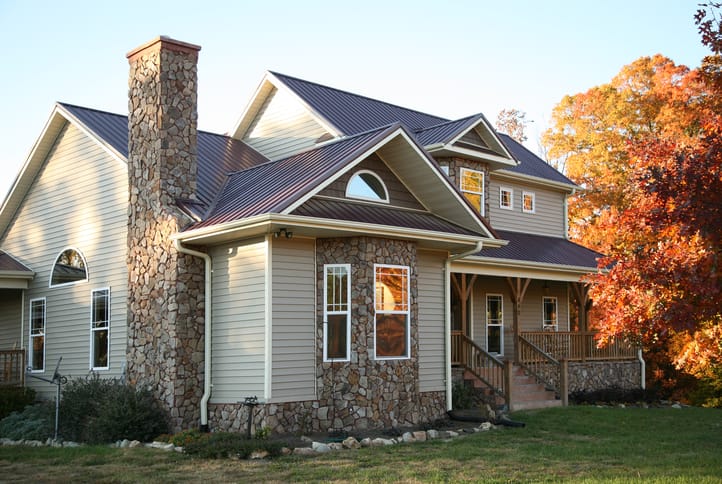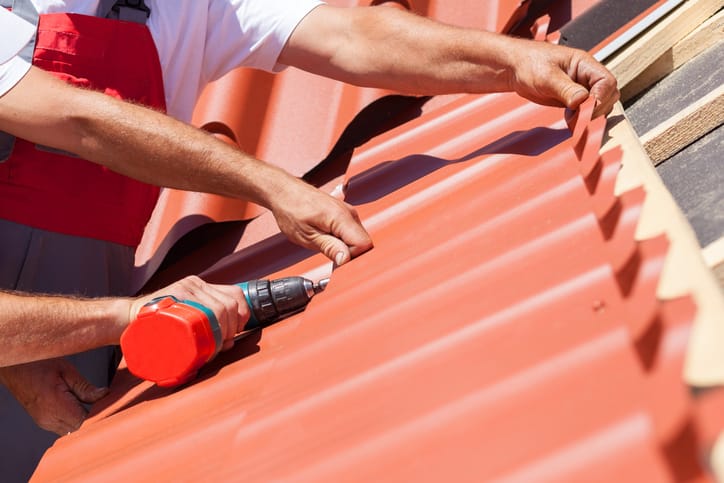5 Reasons Why You Should Try Metal Roofing
You noticed the trickle of water down the bricks of your fireplace. You saw it first a few months ago, and now it’s happening again. This time it’s more than a trickle, so you call in a roofing contractor, who delivers the news—you need a new roof.
Now you must decide what type of material you want for the roof—asphalt, wood, slate, tile, or metal. You’ve seen metal roofs on some of your neighbors’ houses, and you think they are very attractive. It also makes sense to you that they would last a long time because of the durability of metal. But beyond that, you know little about them.
Here are some things to keep in mind when choosing metal roofing:
Metal Roofing Lasts Longer
Metal is a term that covers quite a bit of territory. Here is a list of the most popular types of metal roofing material. Keep in mind that these materials are low-maintenance and will last two to three times longer than an asphalt roof. They usually carry a 20 to 40-year warranty, but many will last much longer:
- Galvanized G-90 steel: Long-lasting but is subject to corrosion in salt-spray environments near the ocean. It’s frequently chosen because of its low cost.
- Galvalume steel: Zinc and aluminum coated steel that’s more expensive but longer lasting than G-90.
- Aluminum: Second in popularity to steel, it lasts longer than steel but costs much less than premium metals like copper. Suitable for coastal areas.
- Copper: The most durable of the roofing materials, it can last for over one hundred years. Because of its high cost, however, it is often used sparingly as an accent above bay windows or porches.
Lightweight and Fire-resistant
Some roofing materials, including asphalt shingles and wood shakes, are less resistant to fire than others. Metal roofing is one of the materials that is recommended as a safer option. It is recognized by fire departments and by building codes across the country for its resistance to flames.
Although other materials—tile, for instance—are also fire-resistant, they are heavy and more likely to collapse. Because of this, firefighters cannot safely go inside a burning house with tile roofing for fear of losing their life or, at the very least, injuries. With a lighter weight metal roof, it is safer for them to go inside and fight the fire more efficiently.
Even if it’s not your house that’s burning, embers from a fire in your neighborhood can land on your roof. A metal roof offers protection from that, too.
Saves Money and the Environment
Installing a reflective metal roof can save you up to 40% in cooling expenses. Highly emissive metal roofs, either pre-painted or granular coated, can reduce urban air temperatures by as much as 12 degrees. Not only do these roof systems reflect most solar radiation, but they re-emit any radiation that is absorbed.
Since most metal roofing comes in larger sections, a contractor can install it quickly, giving it another money-saving feature.
If those savings aren’t enough, in some states you can get a homeowner’s insurance discount of up to 35%.
Also, since most metal roofing has 30-60% recycled material and can be installed directly onto an existing asphalt roof. This speeds up installation and helps to reduce landfill waste. Traditional roofing products, which include asphalt shingles, add approximately 20 billion pounds of waste to U.S. landfills annually.
Another environmental plus: Metal roofing material is 100% recyclable at the end of its service, making it an economical and environmentally-friendly choice.
Maintenance-free
Metal roofing is one of the toughest, most maintenance-free roofing materials available. When compared to asphalt shingles, it is much sturdier and better able to resist rot, mildew, the wind, and termites. Some metal roofs come with a 50-year warranty, and the replacement cycle is over three times longer than with typical asphalt shingles.
It’s recommended that you use baked-on enamel finishes with rustproof undercoating that are warranted for the life of the product. The finish won’t crack, and those little granules on asphalt shingles won’t be shedding. So, you won’t be climbing there to scoop them out of the gutter every spring and fall.
There are two types of rust-proof undercoating. For reliable protection from rust, The Metal Roofing Alliance recommends:
- For galvanized zinc undercoating: A galvanizing thickness level of at least G-90
- Galvalume undercoating: Thickness levels of AZ-50 or AZ-55
Looks Great
Do you picture barns and airport hangars when someone mentions a metal roof? It’s no longer true. Metal is a smart look for your home, and with a broad range of styles and colors, they are quickly catching on. In addition to the standing seam panels–those with ridges running from the peak to the eaves—new metal roofing includes products that mimic slate, clay tiles, and wood shakes.
Don’t believe the most common myths about metal roofing.
- A metal roof will not increase the risk of lightning striking your house. If lightning does hit your house, your metal roof will disperse the energy safely throughout the structure.
- They are not noisier than other types of roofing. If installing over solid sheathing, a metal roof will make no more noise than an asphalt roof.
- They are not susceptible to rust. Either premium G-90 galvanizing or an anti-corrosion aluminum/zinc coating covers the metal.
- Metal roofs do not dent easily. They can withstand hail, high winds, and heavy snow.
- In the long run, they are not expensive. A metal roof can last a lifetime, increase the resale value of your home, and reduce your cooling costs by as much as 40%.
The extra investment in a metal roof is an excellent value for anyone looking for longevity, appearance, and performance in their new roof. It only takes a little research to understand why so many people are choosing metal as their next roofing purchase.


